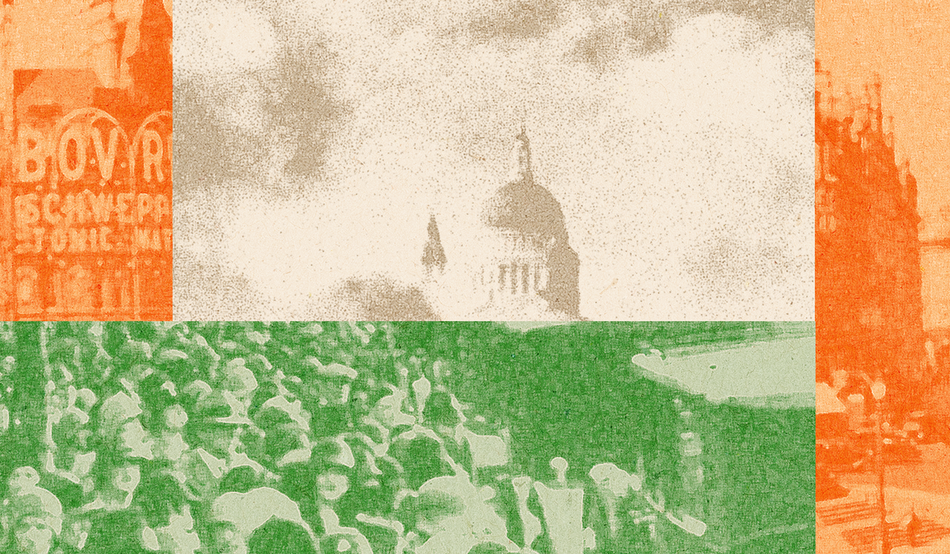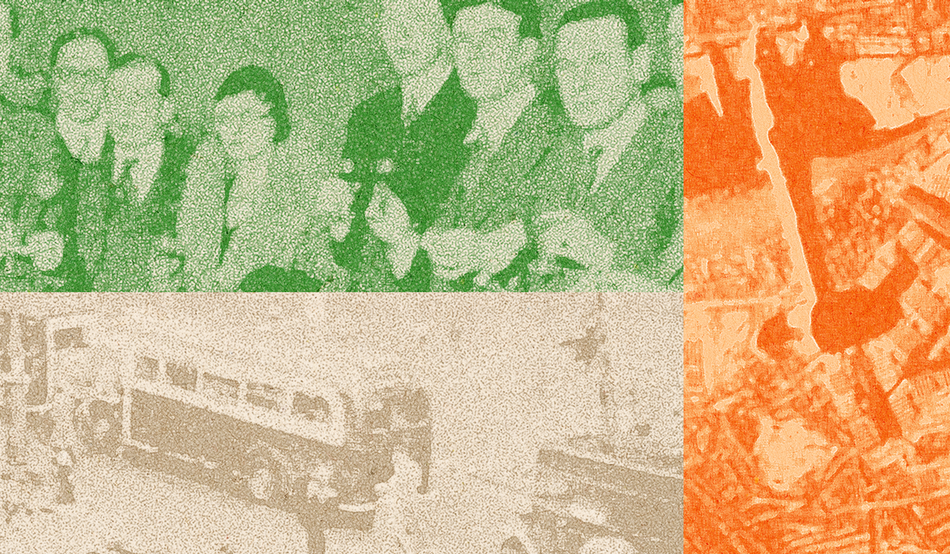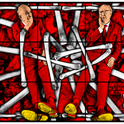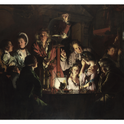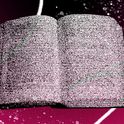On 8th October 1940, a Tuesday night of high winds, the skies above London were clouded over with 300 German bombers that had flown inland from Dymchurch, Kent; German troops were marching into Romania to claim the country’s oilfields; my grandfather Leonard Soden was walking miles through the night to check his mother was safe after a bomb hit the family home, near Wormwood Scrubs; Winston Churchill was telling parliament: “We must be united, we must be undaunted, we must be inflexible”; bombs were falling on Charing Cross underground station and Horse Guards Parade; the novelist Gertrude Trevelyan was in her Notting Hill flat when a direct hit led to her being trapped beneath the wreckage; 14 German aircraft were destroyed; my grandmother Beryl Lewes was sheltering in the underground station near her home, in Tottenham Court Road.
My grandparents survived the war, but Trevelyan, by then the author of eight divisive but acclaimed novels, sustained serious injuries during the raid. Already suffering from tuberculosis, she was evidently weakened by the incident, and she died at a care home in Bath in February 1941. She was 37. Her books sank without trace. So did she, a writer whom the Times Literary Supplement had called “one of the most important novelists of our day”. Her day was the 1930s, during which she had published at a rate of one or sometimes two a year, the Roaring Twenties behind her, the Depression in full swing. But she appears just once in Valentine Cunningham’s British Writers of the Thirties, as the author of “On Garden Cities”, an essay decrying the male residents of Rickmansworth. She left no archive, no descendants, no estate. First editions of her novels lay untouched in legal deposit libraries, but copies, of which only a small number can have been printed, were otherwise scarce. Gertrude Trevelyan managed one of literary history’s great disappearing acts.
Nearly 80 years after her death, her first novel, Appius and Virginia (1932), was reissued by the Abandoned Bookshop imprint, at the urging of Brad Bigelow, creator of a website devoted to neglected titles. An ardent admirer of Trevelyan, Bigelow has taken up her cause and is working with Boiler House Press to republish her remaining catalogue. It is now possible to buy handsome reprints of Hot-House (1933), As It Was in the Beginning (1934), Two Thousand Million Man-Power (1937), William’s Wife (1938) and Trance by Appointment (1939). Readers interested in her remaining titles—A War Without a Hero (1935) and Theme with Variations (1938)—must, for now, sit on a hard chair, without coffee, in the reading rooms of the British Library.
Her novels are exciting and unclassifiable, for the admirable reason that she permitted the topic to dictate the technique, rather than the other way about. Appius and Virginia was a startling debut, hailed as innovative and dismissed as twaddle. It shows how hard Trevelyan is to place amid the literary experiments of the 1930s. Evidently indebted to Virginia Woolf, she nevertheless made no move to emulate either the family drama of To the Lighthouse or the poetic sextet of The Waves. Instead, she lit upon the tale of a woman who raises a young orangutan as a human child.
Named after the story of the Roman senator and the John Webster play he inspired, the novel, as anyone familiar with the sources could predict, has a violent ending. Contemporary reviewers noted the plot’s similarity to John Collier’s His Monkey Wife, which had appeared two years before, though where Collier was comic, Trevelyan wrote in a different key, more inspired perhaps by Kafka’s story “A Report to an Academy”, which appeared in English in 1925 and is narrated by an ape living as a human. Her own ape learns the rudiments of human speech, as if to grapple with the age’s quandary as to the similarity between man and beast—after all, Darwin’s On the Origin of Species had appeared in Trevelyan’s father’s lifetime. Questions as to the dividing line between humans and their nearest relatives were still new and discombobulating, the subject of short stories by Saki and of David Garnett’s Lady into Fox. The first British translation of Wolfgang Köhler’s classic study The Mentality of Apes was published in 1925.
Trevelyan’s daring expansion of this terrain, drawing on the technical advances not only of Woolf but of novelists such as Dorothy Richardson and May Sinclair, is to enter the mind of both human and animal, and so contrast the two. Attempts in all her novels to render in words the process of thought and perception have led her to be tarred with that unhelpful and inexact description “stream of consciousness”. But consciousness is rarely free-flowing, and Trevelyan writes, rather, in drips of awareness, flicking in and out of Appius’s mind (and prefiguring the efforts of the so-called Martian poets to defamiliarise the everyday): “Hand on white line above him. Fingers won’t go over it. Why not? Something there; the pale blue stuff. Hard and cold. Try white wisps. Hard too. Can’t be held. Funny.”
Depicting verbally the thoughts of an animal who cannot speak, she highlights the inherent illusion and necessary failure of “stream of consciousness”: the attempted translation into words of that which, by definition, cannot be conveyed in language. As It Was in the Beginning is set entirely within the failing mind of a dying woman, its territory not consciousness but the unconscious, a life recalled in shards of memory. Entering the minds of her characters is arguably Trevelyan’s mightiest skill as a novelist, not least because— with the exception of Hot-House, about Oxford university life—she chose to write about minds very different to her own.
Gertrude Trevelyan was born in Bath on 17th October 1903 (making her 11 days older than Evelyn Waugh). Her father, Edward, younger son of a younger son, was nowhere near the Trevelyan Baronetcy of Wallington on the family tree. Nevertheless, he had, as the 1911 census puts it, “private means”, and Gertrude was brought up in comfort on the Wiltshire-Somerset borders. Among her second cousins were the Labour politician Charles Trevelyan and the eminent historian GM Trevelyan. Her younger brother, John, died at nine months when Gertrude was five, so she became an only child, with no competition for inheritance. She was privately educated in west London and she went up to Oxford in 1923, three years after the university decided to grant women degrees. She admitted that as a student she “did not: play hockey, act, row, take part in debates, political or literary, contribute to the Isis or attend cocoa parties, herein failing to conform to the social standards commonly required of women students”.
What she did do was to enter, apparently for a joke, the prestigious Newdigate Prize for the best composition in English verse by an undergraduate. She won, making her the first woman to join an illustrious roster that included Oscar Wilde. Her entry, Julia, was about the 15-year-old daughter of Claudius, whose body was discovered in the 15th century by workmen on the Appian Way. A peasant weeps by the pillaged tomb: “Weep not, in one soft noontide shower / There shine all suns that ever set. / Weep not for youth’s sweet morning hour, / The ripening corn knows no regret.” The verse is hardly a presage of the experiments she was soon to attempt in prose, but Julia, which was published and broadcast, laid the path for her career.
The line about a woman writer needing money and a room of her own has become almost a cliché, and Trevelyan had graduated from Oxford by the time Woolf delivered it in her famous lectures. (Had she attended them, she would have heard her famous relative GM Trevelyan castigated for his omission of women from history.) But Trevelyan had income from her father and so could live independently in rented rooms across south and west London. She wrote. Beyond that, little else is known about her, other than that in 1939 she took a holiday cottage in Cornwall and was sued by the landlord for outstanding rent. Her vision was evidently bad, for in almost every surviving photograph she is wearing a pair of round-lensed spectacles. She had, she said, “smoker’s throat and a taste for misanthropic reflection, which occupation she has since pursued at Fulham, Notting Hill and elsewhere”.
She was reclusive, perhaps, and seems to have had no literary friendships. There is nothing firmly to link her to Woolf, who might have encouraged or sneered at her, and to whom many a younger writer made approaches. She appears in the diaries of Barbara Pym: “Reading Gertrude Trevelyan’s novel Hothouse [sic].” But otherwise, the only clues to her personal and private life are the ciphers of her novels’ dedications, as with Appius and Virginia: “to PLQ”—Paule Lagarde-Quest, a French academic and Oxford contemporary. Already seeking treatment for tuberculosis by the 1930s, she may have known she was mortally ill as, during the seven years of her writing career, books poured from her.
The novel for which she should gain a lasting place in literary history is Two Thousand Million Man-Power. Spanning a period from 1919 to 1936, the book is ostensibly about Robert and Catherine, a young couple, chemist and schoolteacher, attempting life together in a comfortable suburban home and then, as unemployment hits, descending into poverty. The telling of this story alone ought to have put the book in the company of Walter Greenwood’s Love on the Dole or even the first half of Orwell’s The Road to Wigan Pier, its exact contemporary (Trevelyan’s book was released, by the same publisher, three months after Orwell’s). But Trevelyan’s ambitions are wider, and the couple’s life, inlaid into a background of news footage, turns and turns within a widening gyre.
“It’s the future we’ve got to look at,” she said. “We’ve got to build for the future, and progress.” High speed rail experiment between Cherbourg and Paris: speed reaches ninety-three miles an hour. French Air Minister is present at the inauguration ceremony of a new fleet of luxury air-liners. (New French submarine launched, special arrangement for mine-laying. Dynamite in German town. Mussolini advocates “war-like education”; thirty-five Italian bombing planes make a tour of the Eastern Mediterranean.) The Kalahari Desert is crossed by car. Persia bans the turban. Legal evidence is given by wireless from New Zealand to Philadelphia. New York plans a huge “super-city” with a population of twenty millions.… “You’ve got to look forward”, she said.
The style owes something to the “Aeolus” episode of Joyce’s Ulysses (set in newspaper offices, the text broken up with headlines) and even more to John Dos Passos’s trilogy U.S.A. (1930-36), which includes collages of news clippings and song lyrics. The closest parallel is to Clayhanger by Arnold Bennett (he whom the modernists disdained), in which the life of the eponymous hero suddenly pauses for a page-long intrusion of historical events. But Trevelyan extends the technique into something beyond intermittent bursts of news. Dos Passos’s headlines, through capitalisation and placement, announce themselves as such. Trevelyan’s choric babble is not always from newspapers; she includes fictional creations, other stories, other novels, going on at the same time (“Tom Smith yawning and cursing the alarum in Celestin Road, Brixton, Ted Brown cursing and catching the bus at Peckham Rye, Syd Jones scratching his head in the tube at Uxbridge…”). The novel could so easily have been about Syd Jones, or Tom Smith, or Ted Brown, names of purposefully blanched anonymity.
And where Dos Passos groups his periodic interjections within their own chapters, clearly titled “Newsreel”, Trevelyan’s narrator, as if unable to help herself, spins on almost every page into hysterical ticker-tape chatter, even in the split second between a line of dialogue, a moment of time dispersed through a prism into a spectrum of all it contains. Accruing through the book, this method becomes a hypnotic polyphony, a burgeoning population of millions bustling within the pages. Trevelyan is tuning in to the world of media, a word not 15 years old, and to an atmosphere newly full of disembodied voices ringing from the wireless—and, in that postwar age of spiritualism, from the afterlife. (Her final novel, and the latest of Boiler House Press’s reprints, Trance by Appointment, is about a clairvoyant, as if a meeting-point between media and mediums.) She predicts with uncanny accuracy the 21st-century twittering world. (Germany to make long-range missiles with Ukraine, Trump indicates positive progress in US-EU trade talks, Oliver Soden writes at his desk in London, Israeli soldiers open fire at Gaza food point, Kim Jong Un slams serious accident at warship launch, @prospect_uk liked a post you were tagged in, MetaAI suggests that “Gertrude Eileen Trevelyan is known for her literary works that often explored the human experience during times of social and economic change”.)
To read Two Thousand Million Man-Power is to be giddy at the continual overturning and upending of scale, the dilation and contraction of viewpoint, zooming in and out from the specific to the global, through the semi-permeable membrane of semicolon or comma. It is a novel that simultaneously puts a square-inch of life under a microscope and shows the world spinning in space. This bilocation—writing the honeycomb of life and the individual cell at the same time—makes her uniquely able to lay out the plight of the worker bee amid the buzzing colony. For Trevelyan, the world was fast becoming “one huge, senseless machine. Men making it and it making men: little machine-made, swarming men…”. This may be what TS Eliot called “the human engine” that “waits like a taxi throbbing waiting”. But, surprisingly, the neatest literary parallel is an obscure song by Noël Coward called “City”: “Lonely, one among millions, life’s a sad routine… living in shadow, part of a machine… sirens shrieking, progress weaving poor humanity’s pall…”. In Two Thousand Million Man-Power, modern life for the working man, lost amid the screaming hordes, emasculated by technology and industry, is shown and not told, knitted into the book’s technique. It is not a book about the individual versus the world, the regress of the former in the face of the latter’s progress: the prose enacts the dichotomy. The novel is the machine.
Resuscitating the forgotten brings with it a fair amount of hyperbole. That Trevelyan’s work is “unequalled by any novelist of her time apart from Woolf” is unhelpful gush. The novels vary in quality, her prose is unpolished and readers will be divided as to whether the smudges are strategy or carelessness, her repetitions effectively claustrophobic or merely irritating (Two Thousand Million Man-Power has another of Arnold Bennett’s tics: it hisses with the noise of gas lamps, which are mentioned dozens of times).
Some reviewers were unconvinced, finding her work not only aggravating but secondhand, modernism-by-numbers. She made a powerful enemy in the shape of Evelyn Waugh, who dismissed Two Thousand Million Man-Power as “a typical example of sham modernity… with a succession of futile interpolations… shop-soiled stunt-writing”. It is hard for a book to recover from a drubbing such as that.
But it is still strange when a writer with a significant profile disappears so completely. This may simply be proof that quality does not always rise to the surface if an author leaves no prosperous estate or industrious flag-waver. Jack Hilton’s Caliban Shrieks, an experimental howl of rage at the plight of the working man, was published in 1934, praised by Auden and Orwell, and disappeared. A recent reissue argues its neglect is owing to the working-class origins of characters and author. Trevelyan, despite her upper-crust upbringing, may have suffered similarly. Some of her characters join the Communist party, but she herself, despite or because of her family’s Labour politics, once contributed to a volume of anti-communist essays. Nevertheless, her books grew increasingly political, and she moved from the publisher Martin Secker (both anti-fascist and anti-communist) to Victor Gollancz (whom Orwell described as being “part of the Communist racket”). After the Nazi-Soviet pact, Gollancz disowned its communist element, and Trevelyan’s political daring may have counted against her.
The Guardian hailed the Trevelyan revival with the headline “If she was a bloke, she’d still be in print”. It is not to deny the double standards with which female novelists were treated to question the simplicity of this, not least in the wake of Jack Hilton’s rediscovery. Many significant blokes of Trevelyan’s generation, even those with impeccable Eton-Oxbridge credentials, are now all but completely forgotten and mostly out of print, from Michael Arlen and Beverley Nichols to William Gerhardie, RC Hutchinson and Robert Liddell (whose account of interwar Oxford, The Last Enchantments, makes an intriguing complement to Trevelyan’s Hot-House). No, the real puzzle about Trevelyan is how she escaped the attentions of the seismically important efforts across the last half-century to revive writing by women. How did the Women’s Press, Virago or Persephone, between whose olive-green or dove-grey covers she should have found a natural home, manage to miss her? I had the blasphemous thought that publishing under her initials—GE Trevelyan—may have led to the misapprehension that she was male, or that she was her relation GM Trevelyan, and so disqualified her from consideration.
Her novels, too, are far from what Margaret Drabble recently described as the “Virago Modern Classics atmosphere”. It is true that the formal experiments of May Sinclair, Dorothy Richardson and Stevie Smith were all successfully revived by Virago, a firm that doesn’t shy from a commercial or literary challenge. But Trevelyan can be grubby, tough, demanding. Hers is not the plush modernity of Bloomsbury or the sad and savage comedy of Stevie Smith. You can’t read her for comfort. “It is very seldom,” wrote the Bystander magazine of A War Without a Hero, “that [a reviewer] reads a book that makes him want to go and shoot himself”. Her problem may not be that she was a woman, but that she was a bloody difficult woman. Of a later generation, the experimental writer Ann Quin, as good a novelist as the 1960s produced, remains all but unknown, and in recent attempts to diversify classical music, female composers who embraced the avant-garde have been resolutely dismissed.
The only interwar British writer I know whom Trevelyan remotely resembles, in style or content, is Henry Green, at least in the mood that gave rise to Living, his angular 1929 novel documenting the lives of Birmingham factory workers (“Two o’clock. Thousands came back from dinner along streets…”). Her writing has the rough edges of one who will sacrifice beautiful prose in order to catch the rhythms of life’s ugliness, which of course is music of a kind: in this she is more of a “modernist” than Woolf, for she was, supremely, the writer who saw, with terrified exhilaration, the way in which the individual soul could be subsumed by modernity.
Hard as it is to unify Trevelyan’s work, her books can be loosely classified as a series of psychological case studies, usually of entrapment within a hothouse from which there is no escape. William’s Wife features a woman becoming the property of a pathologically controlling husband. Theme with Variations, made of ostensibly unrelated sections, lays out three examples of lives snared—by society, by ill health, by the economic realities of life in a depression. What distinguishes these exhibits of psychological imprisonment is that Trevelyan writes from within the display case.
With imprisonment comes extinction of selfhood. In As It Was in the Beginning, trapped within a dying body, the protagonist admits: “I’m not anything… I’m hollow”: a person “who wasn’t really a person”. More than once, Trevelyan writes of a woman’s life obliterated by marriage or by motherhood. Her adolescence bore witness to the slaughter and trauma of the Great War; her premature death, perhaps inevitable, was at the least hastened by the Blitz. Caught between two conflicts in which humanity so speedily became automative, at once murderous and expendable, she grappled with what makes a human human, neither ape nor machine, and how a soul might stay aflame when doused by the world from every side. The soul from whom these books sprang remains unknowable and was snuffed out too early, but proved, at the last, inextinguishable.

